At the end of May, severe
to extreme drought was concentrated in the Southeast, Southwest,
western High Plains, and extreme northwestern Great Lakes. Drought
and abnormal dryness covered a broad swath from the Southwest
through the northwestern Plains into the Upper Midwest, as well as
another area across most of the Southeast (May 29 U.S.
Drought Monitor). Extreme short-term
dryness during May across much of the country east of the
Mississippi River contributed to worsening drought conditions with
dryness and drought expanding into the Ohio Valley. Abnormally dry
May weather in the West contributed to worsening conditions across
California, Nevada, and eastern Oregon (May 29 vs.
May
1 U.S. Drought Monitor). Conditions deteriorated across the
Hawaiian Islands but improved across Montana and the Dakotas.
For the Southeast region, the
last 6
months have been
persistently dry. In fact, December-May has been drier than
average for 7
of the last 9 years. Several states had the driest December-May
(Mississippi) or March-May
(Alabama, Georgia, Mississippi, Tennessee) in their 113-year
record.
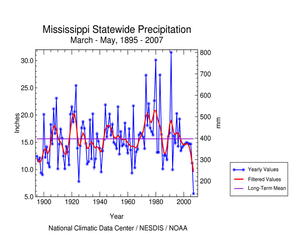
Several stations in the Southeast reported record low May and
spring rainfall. The lowest reports included: Macon, GA with only a
trace of rain during May; Tuscaloosa, AL at 0.06 inch; and
Anniston, AL with 0.14 inch. Tallahasse, FL had only 2.24 inches
for March-May, compared to a spring normal of 15.01 inches, and
surpassing the previous record of 3.35 inches set in 1925.
The West region had its
6th
driest spring (March-May) on record, but its driest
June-May. This is in sharp
contrast to the unusual wetness of the last two such 12-month
periods, and marks a return to the dryness of the previous
6 years.
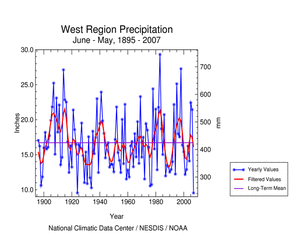
|
|
The May precipitation
pattern at the primary stations in Alaska
was mixed. In Hawaii,
dryness continued throughout most the State. The pattern for spring
(March-May) was similar to that for May for both Alaska
and Hawaii.
In Puerto
Rico, the month was predominantly dry along the southern and
eastern sections but wet in the northwest (based on National
Weather Service radar estimates of precipitation), similar to
the pattern for the year-to-date.
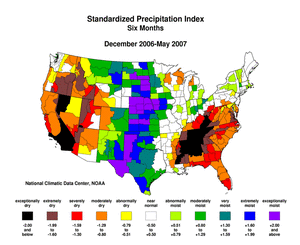
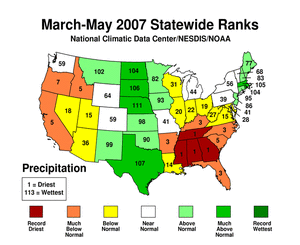
The drought was reflected in several indicators, including: low
soil moisture (modeled
and
observed), streamflow (modeled
and observed),
and snowpacks,
stressed
vegetation, numerous large wildfires (May
1,
10,
20,
31,), and
deteriorating pastures. As of May 20, 96% of the pastures were
in
poor to very poor condition in California
and, in Georgia, at 79%
poor to very poor, pasture conditions were the lowest
of the last 12 years.
As summarized by the
Drought Impacts Reporter, the drought has stressed crops in
Alabama and delayed crop planting in other states. With ponds and
lakes shrinking and wells going dry, watering restrictions and burn
bans are in place in many Southeast communities. A state of
emergency declared by Georgia Governor Purdue has been extended
through June 30. In Florida, 24 counties have been declared
disaster areas due to drought conditions and the February freeze,
and 41 Alabama counties were declared agricultural disaster areas.
Drought warnings were in effect for 37 Alabama counties. By the end
of the month, Lake Okeechobee's level fell to 8.94 feet, breaking
the record low of 8.97 feet set back in May 2001. In the West,
parts of California were declared natural disaster areas due to
drought since October 2006, and a local drought disaster was
declared in eastern Oregon. |
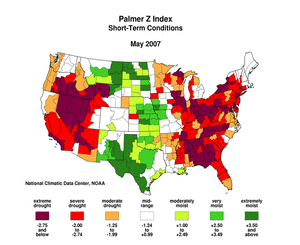





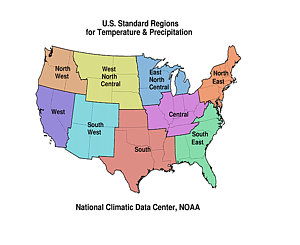
 NOAA's National Centers for Environmental Information
NOAA's National Centers for Environmental Information
